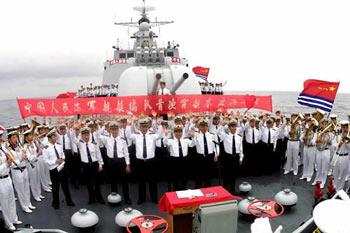For the most part, the Chinese navy has been relatively isolated, and something of an unknown quantity to outsiders. But a growing military strength has come in line with a growing military openness.

The navy is reaching out for more foreign exchanges, and it's showing off its newest vessels to the world.
A journey to reach out that's becoming more frequent for the Chinese navy.
The fleet that left Sanya this February was among the country's latest heading for friendly visits and joint drills.
The first such visit was in 1985, and the destination was Pakistan. Since then over 50 vessels have visited more than 40 countries. They brought not only a message of friendship, but also the latest technology of the Chinese navy.
He Xin from Chinese Naval Fleet said, "All our visiting vessels are of the newest type designed and produced by China since the late 1970s. This includes the missile destroyer, missile frigate, and ocean-going training and supplying vessel."
Long-time navigation in the ocean is a real test of Chinese-made ships. And the successful journeys have proven their sea-worthiness.
The destroyer Shenzhen is a star on China's maritime diplomatic team. It has visited the most countries, and joined China's first rescue drills overseas.
But it was the destroyer Qingdao that accomplished the navy's first journey around the globe, in 4 months. Apart from its diplomatic role, the ship also has special meaning for overseas Chinese.
Qie Xingjing, officer of Destroyer Qingdao, said, "What touched me most are overseas Chinese who welcomed us at each of our stops. The vessel is a floating island. Many of them are so excited and even burst into tears on boarding our ship. They think the visiting fleet represents the stronger role of our nation."
And the Chinese navy also opens its door to the coming guests. Since a French destroyer visited Shanghai in 1978, over 100 naval fleets from more than 50 countries have called at Chinese ports for joint drills.
Building ties between China and the world for peace and joint efforts on maritime security and a sign of growing openness from greater military strength.
(CCTV April 23, 2009)